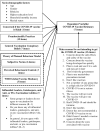COVID-19 vaccine hesitancy and its associated factors in Malaysia
- PMID: 36048822
- PMCID: PMC9436036
- DOI: 10.1371/journal.pone.0266925
COVID-19 vaccine hesitancy and its associated factors in Malaysia
Abstract
The success of the COVID-19 vaccination programme to achieve herd immunity depends on the proportion of the population inoculated. COVID-19 vaccination hesitancy is a barrier to reaching a sufficient number of people to achieve herd immunity. This study aims to determine the prevalence of COVID-19 vaccine hesitancy and to identify the reasons contributing to vaccine hesitancy using the Theory of Planned Behavior. A cross-sectional online survey was conducted between May 2021 to June 2021. Using exponential non-discriminative snowball sampling, participants were recruited via social media and telecommunication platforms. We used a questionnaire that obtained information on participant socio-demographics, vaccine hesitancy, pseudoscientific practices, conspiracy beliefs, subjective norms, perceived behavioural control, main reasons for not intending to get the COVID-19 vaccine; influential leaders, gatekeepers and anti-or pro-vaccination lobbies; and global vaccine hesitancy. A total of 354 responses (mean age = 32.5 years old ±13.6; 70.3% females) were included for analysis. The prevalence of COVID-19 vaccine hesitancy was 11.6%. COVID-19 vaccine hesitancy was significantly and positively associated with those who agreed with influential leaders, gatekeepers, and anti- or pro-vaccination lobbies (adjusted B coefficient = 1.355, p = 0.014), having a "wait and see" attitude to see if the COVID-19 vaccine is safe (adjusted B coefficient = 0. 822, p <0.001), perceiving that the vaccine will give them COVID-19 (adjusted B coefficient = 0.660, p <0.002), planned to use masks/others precautions instead (adjusted B coefficient = 0.345, p = 0.038) and having higher scores in conspiracy beliefs (adjusted B coefficient = 0.128, p <0.001). Concern about the costs associated with the vaccine (adjusted B coefficient = -0.518, p <0.001), subjective norms (adjusted B coefficient = -0.341, p <0.001), and perceived behavioural control (adjusted B coefficient = -0.202, p = 0.004) were negatively associated with vaccine hesitancy. COVID-19 vaccine hesitancy in Malaysia is low. Several factors were identified as being associated with vaccine hesitancy. Factors associated with vaccine hesitancy would be useful in tailoring specific interventions involving positive messages by influential leaders, which address vaccine misinformation and the wait-and-see attitude which may delay the uptake of COVID-19 vaccines.
Conflict of interest statement
The authors have declared that no competing interests exist.
Figures


References
-
- World Health Organization. The current COVID-19 situation [Internet]. 2021 [11 August 2021]. https://covid19.who.int/.
Publication types
MeSH terms
Substances
LinkOut - more resources
Full Text Sources
Medical

